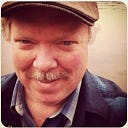Do You Want To Be An Artist? Learn to Color Well Outside the Lines
The artist understands from years of practice that the act of making art, film, advertising, or music is what matters. In fact, the act of making art matters much more than any outcomes that result from this act. Put another way, the creative process is where all the action is and once a piece or a project is completed, the artist longs to get back into the zone where making meaningful things is a deeply satisfying way to spend one’s day.
The artist that manages to somehow make a healthy living by selling their work, learns many “art of business” lessons along the way. In business circles, the deafening drumbeat is all about the need for a distinct and singular focus. The idea is to become so well known for the one thing you do best that people begin to line up to buy from you. It does make sense from a marketing communications perspective because people want to buy the best guitar, the best goat cheese, or the best vacation experience that they can possibly afford, so they look to buy from the clear specialist in the field.
The need for a singular focus clearly helps to sell what the artist makes — it’s how you communicate intrinsic value to an audience. But the act of making art is something else entirely. When you’re making art, you recognize and practice the forms and traditions of the masters, and then, when you know all the rules and how to follow them, you begin to veer from the norm and shape your own point-of-view into something new that’s uniquely your own creation.
First We Innovate Inside of Our Chosen Form
I’m a writer who works in advertising where I generate ideas for clients. I also write short fiction, essays, poems, and journalism. Are there writers who only work in one of the above forms? Yes, of course, just like there are filmmakers who only make romantic comedies and musicians who play the blues and only the blues.
For me, it’s all a tapestry. Ads, stories, essays, poems, and journalism are narrative threads that I weave. I do this because it’s natural for me, but I am also aware that the disciplines bleed into one another, and how. Ad copy, when it’s good, is a form of corporate poetry. Long-form journalistic storytelling is also a huge part of marketing communications, where serial content is often a key component of a brand’s methodology and consequent success.
Cross-Training Is Critical for Artists
In sports and fitness, you want to build a complete set of muscles, so you work them all via a cross-training regimen. Artists have the same need to stretch out and make sure all their muscles are engaged in creation.
Jerry Garcia was an accomplished painter. Steve Martin is an accomplished banjo player. Exceptional artists may achieve levels of greatness and notoriety in more than one format, but it’s rare and it’s also not the point. The point is to stretch your creative muscles and to develop new ones.
How we see the world is shaped by the tools, the training, and the approach we take. So, to change your point of view, change your tools. A writer who takes up ceramics may never make beautiful pots, and the painter who plays piano may sing off-key. So what? The writer and the painter will have achieved the desired end — to properly stretch their creative muscles.
We live in a society that values outputs, therefore we are trained to think that any activity we pursue with a passion has to produce notable and visible results. Not so. The doing of a thing and the process we follow to do it well are also meaningful and important.
If you like what I wrote here, maybe you will like my newsletter too. Thanks for being here now.
